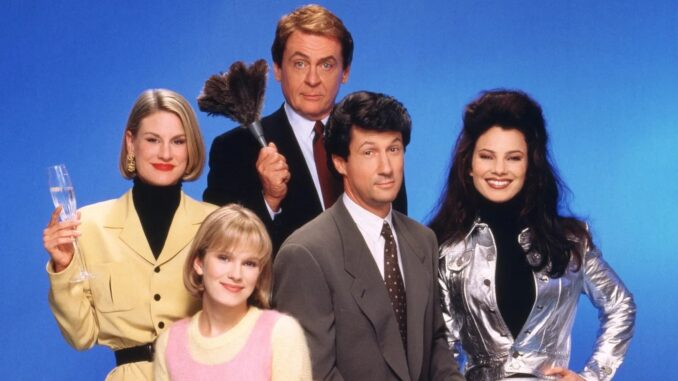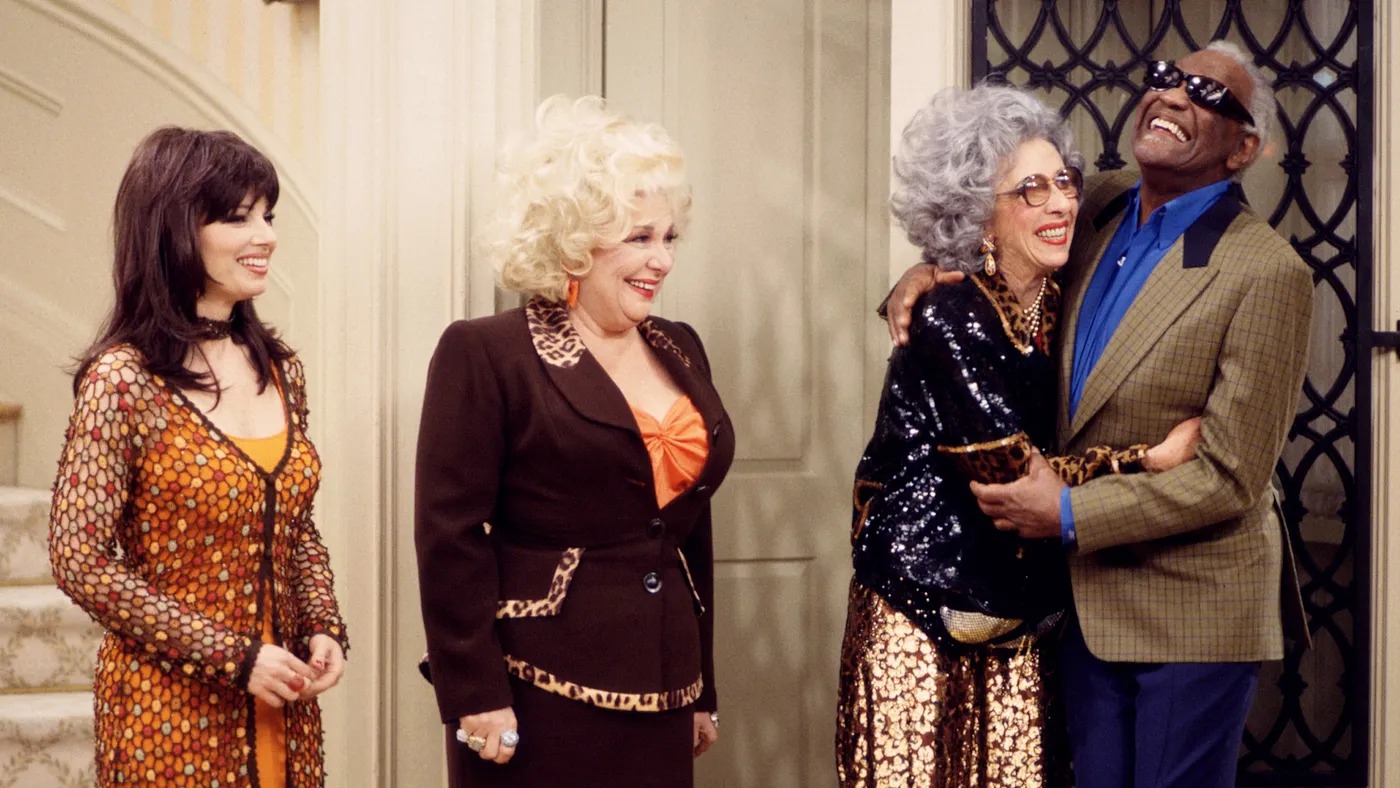
After years of only being available on DVD and reruns on obscure cable channels, Fran Drescher’s classic 1990s CBS sitcom finally made its streaming debut on April 1st via HBOMax. Having recently rewatched the series in its entirety on DVD, I can attest that it is certainly worth revisiting — and that it is possibly the most underrated comedy series of the 1990s.
The Nanny’s Six Season Run, Objectively Speaking
The Origin. The famous Nanny began by pure happeningstance when Fran Drescher ran into current CBS President Jeff Sagansky on a transatlantic flight. She had recently starred in a short-lived series for the network (Princesses, co-starring Twiggy and Julie Hagerty) and managed to convince Sagansky to let her and her then-husband Peter Marc Jacobsen pitch a show to him. He agreed.
When they got back to Los Angeles, Drescher and Jacobsen made the pitch to Sagansky — it would be like The Sound of Music, but instead of a compassionate ex-nun played by Julie Andrews, a brash and sexy door-to-door makeup salesgirl from Queens showed up at the door. Sagansky was sold. Drescher and Jacobson teamed up with Robert Sternin and Prudence Fraser, another husband-and-wife writer-producer team who had success in the 1980s with the Tony Danza-Judith Light sitcom Who’s the Boss?.
The show premiered on CBS on November 3, 1993 and ran for six seasons, amassing 146 half-hour episodes. For historical context, it premiered a few months after Cheers wrapped and spun-off into Frasier.
During its first year on the air, Roseanne, Seinfeld, and Murphy Brown were dominating the Nielsen ratings. It was a year after The Golden Girls wrapped and a year ago Friends would soar into the stratosphere. It was arguably the second golden age of the American sitcom, which undoubtedly contributed to The Nanny being overshadowed and under-appreciated during its initial run.
Author’s Note: The remainder of this article contains spoilers about the plot arc of The Nanny. If you have not seen the show and want the plot trajectory to remain a surprise for you, I urge you to bookmark this and return to it once you have watched the show.
The Plot Arc. The show’s masterful and enduring theme song, which was written and performed by Ann Hampton Callaway, sets the plot up quite clearly. Fran Fine was a young woman “working in a bridal shop in Flushing, Queens, until her boyfriend kicked her out in one of those crushing scenes.” Now relegated to selling makeup door-to-door in Manhattan (due to the fact that her boyfriend ran the bridal shop and fired her when they broke up), Fran stumbles upon the mansion of suave, widowed Broadway producer Maxwell Sheffield (Charles Shaughnessy).

Due to a classic sitcom misunderstanding, Fran is mistaken for a candidate for the newly vacant position of a nanny for the three Sheffield children. And “who would have guessed that the girl we described was just exactly what the doctor prescribed?” Fran simultaneously infuriates and charms Maxwell instantly, but he keeps her on because she quickly wins over the three children by injecting some normalcy and warmth into their stuffy, aristocratic existence.
Fran’s arrival at the Sheffield’s home has a ripple effect on many other lives. She inspires rage and jealousy in Maxwell’s producing partner C.C. Babcock (Lauren Lane), who seems to have only one positive emotion in her entire repertoire — an unyielding romantic passion for Maxwell. Fran becomes the confidante and sparring partner of the Sheffield’s long-suffering butler Niles (Daniel Davis). And she quickly becomes the envy of her family back in Flushing, including her tacky and overbearing mother Sylvia (Renee Taylor) and ditzy, hapless best friend Val (Rachel Chagall).
Over the course of the show’s run, the show’s plots, themes, humor, and characters evolved in remarkable ways, while managing to keep true to the core elements that made the show work. The first season emphasizes Fran’s integration into the Sheffield family, with an emphasis on child-rearing that results in heart-tugging moments.
For this reason, the show was written off by many as a TGIF-style family sitcom. But it was anything but that, as was evident to anyone who stuck around for the second season in which the adult ensemble characters were fleshed out, particularly the dynamics of Fran’s family and Niles and C.C.’s hilarious dysfunctional relationship. The third season was filled with “will they or won’t they?” Sexual tension between Fran and Maxwell and amped up the parade of guest stars as the show became a cultural phenomenon.
The fourth season puts another roadblock in the way of Fran and Maxwell’s courtship when he took back the “I love you” he uttered during some extreme turbulence on a flight in the Season Three finale. (On a side note, I will die on the hill that “And then he took it back!” should have been the cultural touchstone that Ross and Rachel’s “We were ona break!” was.) The writers used this twist to spend most of the fourth season exploring Fran’s path to true adulthood. She goes to therapy, she assertively searches for a man, and she stands up to friends and colleagues. And by the end of the season, her profound growth has won over Maxwell and they consummate their relationship.
As Fran and Maxwell’s relationship escalates in the fifth season, C.C. has a nervous breakdown, Niles grapples with the enormous changes, and the focus with Fran and Maxwell shifts from “will they or won’t they?” to “how will they?” as questions arise about child-rearing, class differences, religious differences, wedding planning, prenuptial agreements, and converting their relationship into the physical realm. The sixth and final season of the series chronicles Fran’s journey to assuming the role of Mrs. Sheffield and getting pregnant, while Niles and C.C’s relationship takes a stunning turn.
The Ratings. Although the show wasn’t a ratings blockbuster during its run, its second and third season drew particularly impressive ratings. During this time, the show regularly ranked among the top 20 programs in the United States
However, the show was an unqualified blockbuster internationally. It aired in more than 90 countries and 12 different countries adapted the American version into their own local series, which were particularly popular in Latin America and Russia.
The Awards. Although the show was never an awards juggernaut, it nevertheless managed several high profile nominations despite the fact that it aired against the heydays of shows like Frasier, Seinfeld, and Friends. It was nominated for 12 Primetime Emmys — four in major categories (two nominations for Fran Drescher in Lead Actress, one for Renee Taylor Supporting Actress, and one for Lee Shallat Chemel’s direction) and eight in technical categories (six for costumes, one for hairstyling, and one for lighting). It won one for its costumes. It was also nominated for two Golden Globes (both for Drescher), an American Comedy Award, a TV Guide Award, a Golden Satellite Award, and numerous awards for its younger cast members.
